|
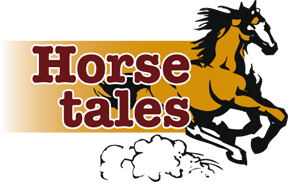
Jayanthi Liyanage
Like to ride a horse?
| [ Horsy quotes ]
He knows when you’re happy
He knows when you’re comfortable
He knows when you’re confident
And he always knows when you have carrots
-Anonymous
The essential joy of being with horses is that
it brings us in contact with the rare elements of grace, beauty,
spirit and fire.
- Sharon Ralls Lemen
(www.quotegarden.com) |
|
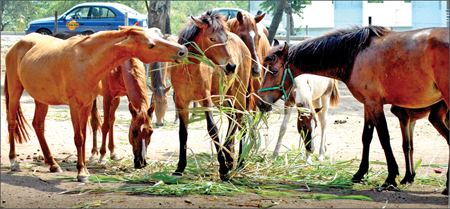
At a grass meal. Pictures by Saman Sri Wedage |
Horse trainer Aruna Priyankara owns 24 horses. He raises them at
Rajagiriya in an open compound which is rented to him.
He maintains four categories of horses – pony, half-breed,
three-quarter breed and thorough bred. The differentiation is according
to height. The thoroughbred is the tallest while the pony, at the other
end of the pedigree spectrum is the shortest. If a thoroughbred stallion
is crossed with a female pony, the offspring would be a half-breed
animal. As Aruna points out, a four year old pony is equal in height to
a three month old thoroughbred horse.
In addition, Aruna has Marwari and Kathiawari horses brought in from
Rajasthan. Their ears are turned inward and they could display dappled
colours.
Aruna trains children and adults in horse riding. A 15 hour course in
brushing, dressing, guiding and riding horses is available at Rs.25,
000.
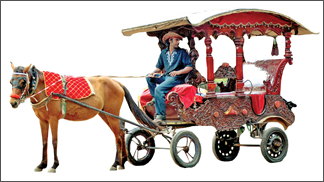
Ready to canter |
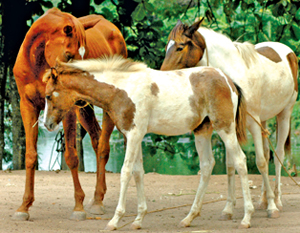
Dappled Marwari from Rajasthan |
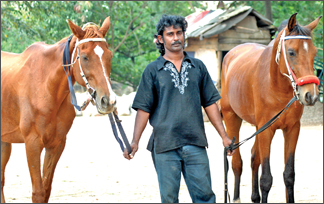
Aruna Priyankara |
The lessons are given early morning or late afternoon as he explains,
“Horses are easy to ride when sun and rain is at a minimum.” The lessons
take place within the compound or out on the road.
Aruna owns two decorative carriages which are used for weddings,
birthdays, Christmas and children’s parties and publicity stints. The
carts are also available for hire on parliamentary grounds on Saturdays,
providing a diversion for children.
Aruna bears the expenses of raising his horses single handed. “When I
saw a friend raising horses, I was attracted to doing it myself,” he
said. “I have to spend quite a lot to feed them.” A thoroughbred or a
half breed animal needs cattle feed costing Rs.150 a day besides three
sheaves of grass per meal. Aruna also gets beer dust from a beer company
and employs his two three wheelers to go in search of grass and bring it
to the compound.

Bridled and saddled |
In the premises, only one male horse is kept with the females.
“Stallions get excited very easily,” said Aruna. “If you keep two
together, it becomes a problem.”
“We have trained these horses in a way that they appeal to children,”
says Aruna. “To get an animal to feel close to a human is a very
difficult thing to do. A strong bond needs to be developed between the
human and the horse. From the first ride, some people fall in love with
the horses.”
Training begins when the horse is about two-and-half-years old. Until
then, the animal is allowed to grow in stature.
At two-and-half-years of age, the horses are saddled. “If you saddle
them before that, they don’t grow to their natural height,” said Aruna.
“At that age, their bones are strong. Past that age, it is difficult to
train them.” A male horse needs to be trained before his attention is
caught up in other things.
Half the animals in the compound are race horses, said Aruna. He is
careful with the animals since one broke both legs and died while
racing. “I must protect what is mine so I am very attentive to the
animal while racing,” is how he looks at the issue.
 |
| From left:
Thoroughbred, ¾ breed, ½ breed, Marwari and pony |
“We must teach our children horse riding,” he insists. “This is a
sport found everywhere. Even if you go abroad, you encounter horse
riding.”
“I have no insurance or earnings. What I earn is pumped back to my
horse business,” he explains that it is only when he sells a foal that
he gets an additional income. A half-breed female costs Rs.1.5 lakhs
while a Marwari costs eight lakhs.
“It is from the mother horse that we gauge the capabilities of a
foal,” says Aruna. “We study up to three generations of horses and know
what the speed of a foal would be.”
In selecting carriage pulling horses, what is required is calmness.
“When we saddle a horse, we understand its temperament,” he said. “We
realise what excites him and what doesn’t. We pick horses that are not
scared of crackers or vehicles and understand about stopping at colour
lights.”
“No horse works willingly,” says Aruna. “They like to be doing
nothing. But once we train them, they understand their job. When
children ride them, they know it is their job and stay calm.”
Being with the horses, throughout the day and throughout their lives,
he is an authority on the likes and dislikes of horses and bringing them
to heel while on the job.
Doting horse
Many passing this open compound where horses dally about in seemly
leisure, would have felt the desire to drop in and get close to them.
We harkened to this bidding and found ourselves in a place where
horses are bred and trained for riding and racing close to nature. No
stables or shelter. They endure sun and rain with equanimity. Those who
love the sun bask in sunlight and those who enjoy rain take a dip in
rain shower.
“Many people are scared to rear horses as it requires many things.
But I bring up horses in the manner that is possible to me,” contented
horse owner Aruna Priyankara candidly concedes. A swarthy young man, he
has three male hands to help with the horses.
While we were speaking to him, two horses came and nuzzled against
our ribs and we fidgeted.
“Not to worry,” pacified Aruna. “They like us. That is why they brush
against us. If you stroke their neck, there is nothing they like
better.”
Every time a horse gets a shade too excited, Aruna would rap crisply
in a strange dialect. “Have you a special language for them?” we asked.
“No,” said the resourceful horse owner. “I speak in Hindi. When we
raise our voice, they know we are scolding and calm down.”
When a helper brought in grass for the horses, two of them started
wrangling. “The ideal thing to do would be to tether them before feeding
as they try to eat each other’s portion,” said Aruna. But except the two
that let go of the wrangle at Aruna’s brisk voice, the others gulped
down their meal peacefully.
“The horse is so close to the humans,” said Aruna. “The real story of
the horse is quite different to what you see from outside. They fall ill
very easily. Common colic is the biggest danger.” The horse is not a
ruminating animal as cattle. Therefore, he overfeeds himself and finds
that what he swallowed cannot be digested.
“Within 24 hours of getting colic, we must spot the symptom and give
medicine. Health is a paramount factor in raising horses and you must
pay constant attention. Another danger is abdominal stones. If not
detected in time and operated on to remove them, a horse can die.”
Nabila who made a commotion and was pulled up, Beebuzy who raced to
clinch the second place at Tissamaharamaya while pregnant and Burger the
calm carriage puller were some of the equines we encountered in the
compound. |



